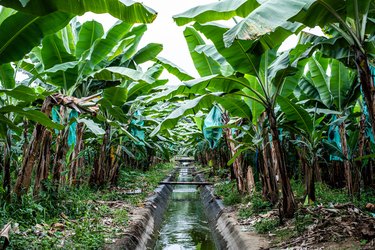
Most people have no idea that they can grow a banana tree (Musa spp.) in U.S. Department of Agriculture plant hardiness zones 5 through 11, depending on the species. Most are tropical plants that prefer warmth and humidity, so the only way they grow in areas that freeze during the winter is by transplanting banana trees into containers. Bananas need almost 18 months of growth before they can produce fruits; move them indoors and keep them warm during the winter months.
Transplanting Banana Trees
Video of the Day
Tropical bananas, such as the 'Dwarf Cavendish' (Musa acuminata), hardy in USDA zones 10 through 11, must be protected from cold. In general, you can dig up these types of banana plants in the garden and transplant into large flowerpots to winter indoors. Alternately, keep them in large containers to facilitate a quick move indoors when temperatures drop.
Video of the Day
Step 1: Move Tropical Bananas Indoors
Move your banana plant indoors when the outside temperatures drop below 50 degrees. If you have a sudden cold snap, wrap the plant in a blanket or burlap covering to protect it from the frost. If you do forget to cover it and the plant seems to have died, dig up the rhizome and bring indoors. After a few days, if there is still life, it will sprout new growth.
Step 2: Trim the Banana Plant
Trim the plant. Bananas trees can grow upwards of 6 feet and will need to be cut back before transplanting. Remove the large outer leaves from the stem with a sharp knife that has been sterilized by dipping in rubbing alcohol or Lysol. Cut back the main stem to about 3 feet high.
Step 3: Remove Extra Shoots
Remove any sizable shoots that have sprouted off the main rhizome by slicing them cleanly with the knife. These can be repotted and brought indoors to stay warm until spring arrives. If they are too small, they may not survive, but it doesn't hurt to try.
Step 4: Dig It Up for Potting
Pull the dirt back from the banana tree to expose the underground rhizome and roots. Dig around the entire plant, slanting your shovel toward the center until you have a nice ball of dirt. Avoid damaging the main rhizome. Lift the root ball from the ground and place it in a planting pot; backfill with potting soil.
Step 5: Put in a Sunny Window
Move the newly planted banana tree inside to a warm and sunny window. Water and fertilize regularly, but do not let the soil get soggy. Rotate the banana tree every week so that it gets light on every side. It should continue to grow, although much slower than outside, unless you have superior lighting and humid warmth in your house.
Step 6: Provide a Summer Vacation Outside
Take the banana tree back outside once the weather has warmed and all danger of frost has passed. Water and fertilize regularly as it is a heavy feeder. Once the fruiting stem emerges, a cluster of flowers forms and then bananas follow. After fruiting, the main stem dies back and must be removed, but the plant will regrow from the side shoots on the rhizome.
Planting Hardy Bananas
Not all of the family Musaceae fruits. Cold-hardy bananas (Musa basjoo) feature the large leaves that give that tropical ambience to the garden, but do not produce bananas. Hardy in USDA zones 5 through 10, the basjoo banana tolerates temperatures down to -10 degrees Fahrenheit if heavily mulched for the winter.
Step 1: Dig the Planting Hole
Dig a planting hole in a sunny, wind-sheltered, well-drained location. Amend the soil as needed with compost and well-decomposed manure. The hole should be two to three times the width of the root ball and at the same depth as the growers pot.
Step 2: Untangle the Roots
Untangle circling and tangled roots. Trim broken and decaying roots as needed with sterilized scissors or pruners. Loosen the edges of the root ball to encourage quick growth into the surrounding soil.
Step 3: Plant the Banana Tree
Place the banana tree in the planting hole at the same level as it was in the growers pot. Back fill and gently tamp the soil around the roots. Water thoroughly.
Step 4: Care of the Hardy Banana
Add a 3- to 4-inch layer of mulch around the banana tree, pulling it back 4 inches from the stem. Water when the soil is dry to a depth of 2 to 3 inches; keep the soil evenly moist, but not waterlogged. Fertilize biweekly with a 8-10-10 liquid fertilizer.